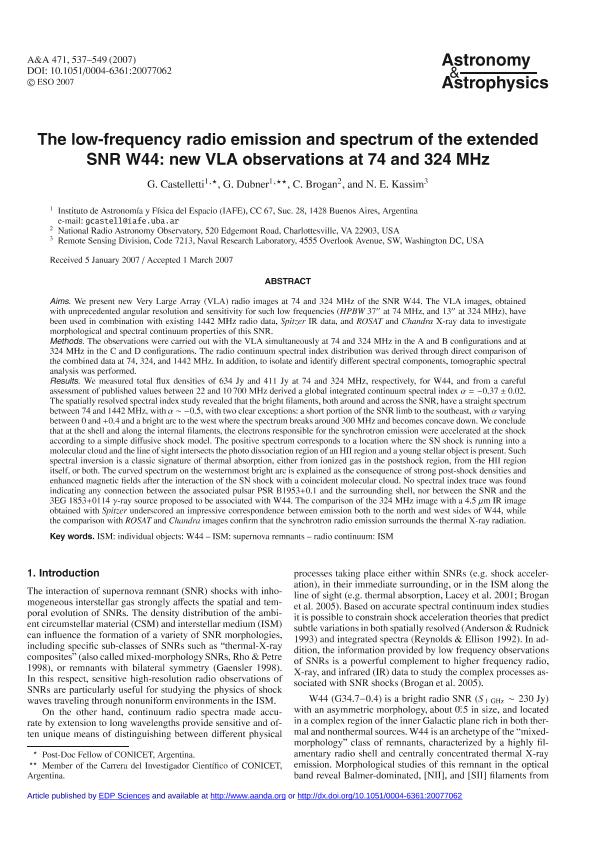Mostrar el registro sencillo del ítem
dc.contributor.author
Castelletti, Gabriela Marta

dc.contributor.author
Dubner, Gloria Mabel

dc.contributor.author
Brogan, C.
dc.contributor.author
Kassim, N. E.
dc.date.available
2017-08-07T22:02:56Z
dc.date.issued
2007-12
dc.identifier.citation
Castelletti, Gabriela Marta; Dubner, Gloria Mabel; Brogan, C.; Kassim, N. E.; The low-frequency radio emission and spectrum of the extended SNR W44: new VLA observations at 74 and 324 MHz; EDP Sciences; Astronomy and Astrophysics; 471; 2; 12-2007; 537-549
dc.identifier.issn
0004-6361
dc.identifier.uri
http://hdl.handle.net/11336/21998
dc.description.abstract
Aims. We present new Very Large Array (VLA) radio images at 74 and 324 MHz of the SNR W44. The VLA images, obtained with unprecedented angular resolution and sensitivity for such low frequencies (HPBW 37 at 74 MHz, and 13 at 324 MHz), have been used in combination with existing 1442 MHz radio data, Spitzer IR data, and ROSAT and Chandra X-ray data to investigate morphological and spectral continuum properties of this SNR. Methods. The observations were carried out with the VLA simultaneously at 74 and 324 MHz in the A and B configurations and at
324 MHz in the C and D configurations. The radio continuum spectral index distribution was derived through direct comparison of the combined data at 74, 324, and 1442 MHz. In addition, to isolate and identify different spectral components, tomographic spectral analysis was performed. Results. We measured total flux densities of 634 Jy and 411 Jy at 74 and 324 MHz, respectively, for W44, and from a careful assessment of published values between 22 and 10 700 MHz derived a global integrated continuum spectral index α = −0.37 ± 0.02. The spatially resolved spectral index study revealed that the bright filaments, both around and across the SNR, have a straight spectrum between 74 and 1442 MHz, with α ∼ −0.5, with two clear exceptions: a short portion of the SNR limb to the southeast, with α varying
between 0 and +0.4 and a bright arc to the west where the spectrum breaks around 300 MHz and becomes concave down. We conclude that at the shell and along the internal filaments, the electrons responsible for the synchrotron emission were accelerated at the shock according to a simple diffusive shock model. The positive spectrum corresponds to a location where the SN shock is running into a molecular cloud and the line of sight intersects the photo dissociation region of an HII region and a young stellar object is present. Such spectral inversion is a classic signature of thermal absorption, either from ionized gas in the postshock region, from the HII region itself, or both. The curved spectrum on the westernmost bright arc is explained as the consequence of strong post-shock densities and enhanced magnetic fields after the interaction of the SN shock with a coincident molecular cloud. No spectral index trace was found indicating any connection between the associated pulsar PSR B1953+0.1 and the surrounding shell, nor between the SNR and the 3EG 1853+0114 γ-ray source proposed to be associated with W44. The comparison of the 324 MHz image with a 4.5 µm IR image obtained with Spitzer underscored an impressive correspondence between emission both to the north and west sides of W44, while the comparison with ROSAT and Chandra images confirm that the synchrotron radio emission surrounds the thermal X-ray radiation.
Ke
dc.format
application/pdf
dc.language.iso
eng
dc.publisher
EDP Sciences

dc.rights
info:eu-repo/semantics/openAccess
dc.rights.uri
https://creativecommons.org/licenses/by-nc-sa/2.5/ar/
dc.subject
Ism: W44
dc.subject
Ism: Supernova Remnants
dc.subject
Radio Continuum: Ism
dc.subject.classification
Astronomía

dc.subject.classification
Ciencias Físicas

dc.subject.classification
CIENCIAS NATURALES Y EXACTAS

dc.title
The low-frequency radio emission and spectrum of the extended SNR W44: new VLA observations at 74 and 324 MHz
dc.type
info:eu-repo/semantics/article
dc.type
info:ar-repo/semantics/artículo
dc.type
info:eu-repo/semantics/publishedVersion
dc.date.updated
2017-08-04T15:44:30Z
dc.journal.volume
471
dc.journal.number
2
dc.journal.pagination
537-549
dc.journal.pais
Francia

dc.journal.ciudad
Paris
dc.description.fil
Fil: Castelletti, Gabriela Marta. Consejo Nacional de Investigaciónes Científicas y Técnicas. Oficina de Coordinación Administrativa Ciudad Universitaria. Instituto de Astronomía y Física del Espacio. - Universidad de Buenos Aires. Facultad de Ciencias Exactas y Naturales. Instituto de Astronomía y Física del Espacio; Argentina
dc.description.fil
Fil: Dubner, Gloria Mabel. Consejo Nacional de Investigaciónes Científicas y Técnicas. Oficina de Coordinación Administrativa Ciudad Universitaria. Instituto de Astronomía y Física del Espacio. - Universidad de Buenos Aires. Facultad de Ciencias Exactas y Naturales. Instituto de Astronomía y Física del Espacio; Argentina
dc.description.fil
Fil: Brogan, C.. National Radio Astronomy Observatory; Estados Unidos
dc.description.fil
Fil: Kassim, N. E.. Spece Sciences División. Naval Research Laboratory; Estados Unidos
dc.journal.title
Astronomy and Astrophysics

dc.relation.alternativeid
info:eu-repo/semantics/altIdentifier/doi/http://dx.doi.org/10.1051/0004-6361:20077062
dc.relation.alternativeid
info:eu-repo/semantics/altIdentifier/url/https://www.aanda.org/articles/aa/abs/2007/32/aa7062-07/aa7062-07.html
dc.relation.alternativeid
info:eu-repo/semantics/altIdentifier/url/https://arxiv.org/abs/astro-ph/0702746
Archivos asociados
